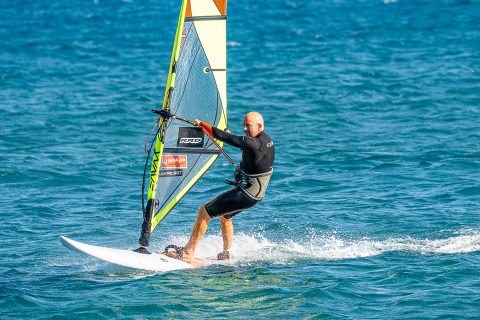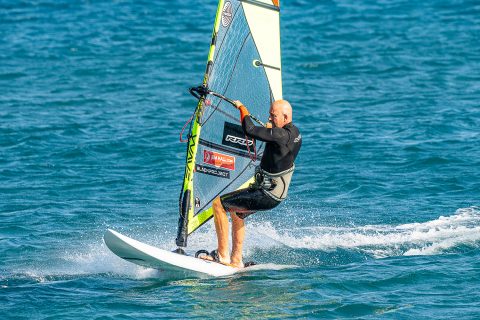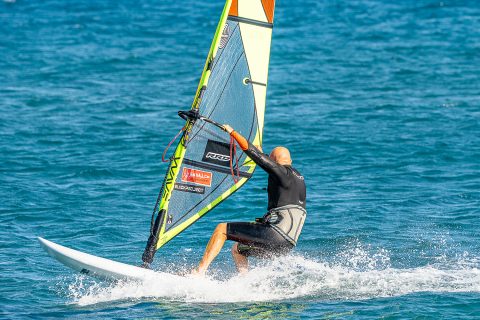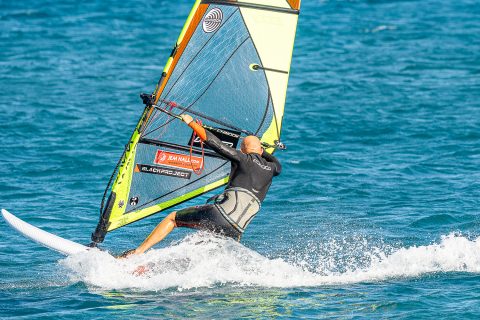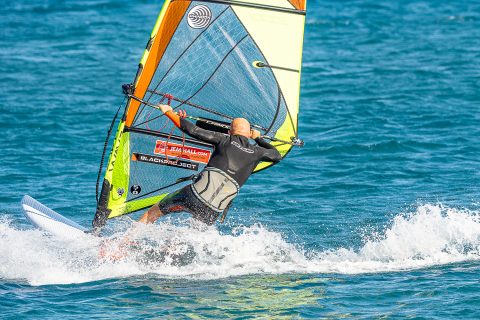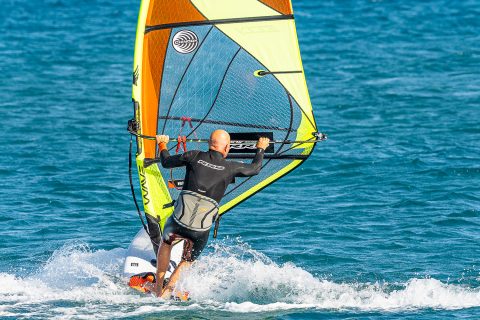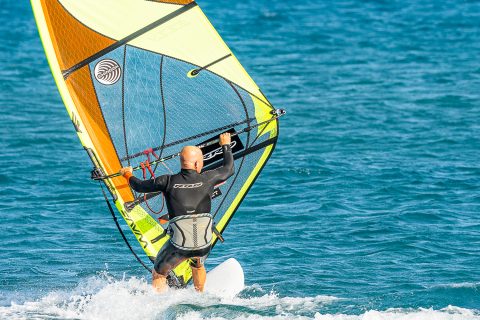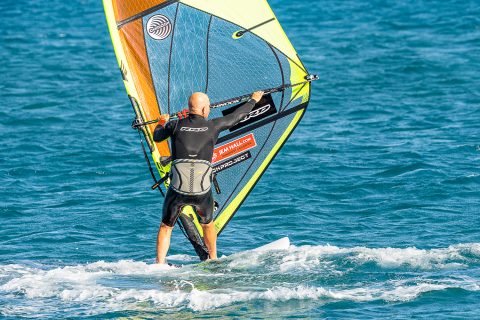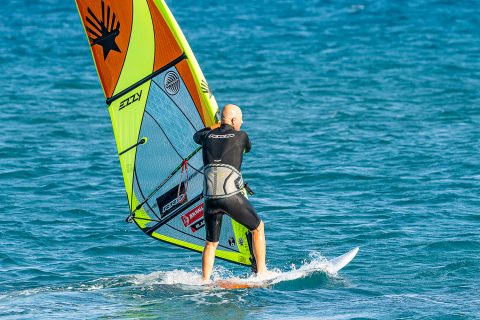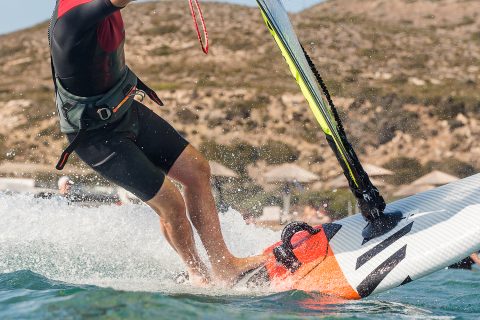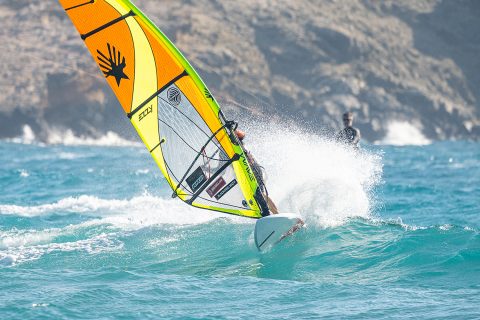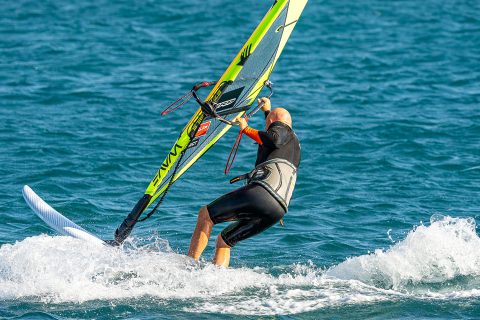JEM HALL
MOVE ON UP – WINDSURFING TECHNIQUE
SLAM IT
MOVE ON UP – with Jem Hall // Slam it
Jem Hall talks tight arcs this month as he gives us tips for the ‘slam gybe’.
The slam gybe is a highly functional tight arc transition that is very useful and will really boost your carving skills, your fundamentals and also your wave riding actions. This builds on my early planing piece as it is often performed when less powered up and it will give you another transition option, alongside the tack.
Photos – Eye Sea You Photo
- Get that back hand back and be ready to unhook and then head upwind. Sheet the sail out slightly to further help slow the board down.
- Back foot comes out and goes right next to the back strap and well over the rail. Sheeting in here will bring you over the board and dump some sail power. Start to weight the tail to lift the nose, as well as lifting up on the front foot and arm.
- Send the rig forwards and across you towards the outside of the turn, send the hips back and across to the inside of the turn, send the nose downwind by pushing away on the front leg as you begin to pull the back foot in. Getting the hips across early is really helped by seeing the clew.
- Exaggerate the rig going out and hips going in as you extend and bend. Think get my arse in the sea! You can add some back foot toe pressure here to assist the turn and the spray throwing too. Pushing down through the front arm, into the mastfoot, is also another turning tool.
- It is a subtle balancing act here between lifting up on the boom to keep board turning on its tail and not sinking the tail too much. Keep the rig away and see the clew way more than I am here. You can see also how far back both hands are on the boom. At dead downwind open the sail and perform the foot change, aiming to get the new back foot towards the rail, where your old heel was. Look to your exit and pull down on the boom to flatten the board in readiness to own the clew.
- Step the new front foot up to the mastfoot and face it forward. Keep seeing the clew and open up the mast hand so the sail can breathe and start to pull you forward.
- Get some balance here and aim to get some forwards motion in clew first; your target is to head downwind on a broad reach. This will lighten the rig and make the rig rotation easier. I pull down a lot on the boom here and push through my front foot.
- Big slide of the front (mast hand) all the way to the front of the boom as you keep looking forward. Then you are ready to release the back hand and actively guide the rig back for a slick rig rotation.
- Reach under and collect the new side of the boom with an overhand grip and send the rig forward to help keep you across the wind and to flatten the board.
Who is this for?
- People who can carve gybe and have done their time on the light wind gybe and have good clew first skills.
- Focused riders who want to gybe better and wish for a bigger choice of arcs in order to have more options to match the power in the sail.
- Most definitely for wave sailors. This means they can ‘tactically’ choose to turn around swiftly on the way out if the set is too big, or wish to turn onto a wave when less powered (even using the swell or wave to help), or wish to have another option for transitioning on the inside, as opposed to a tack.
What is the slam gybe?
It is a tight arc turn, initiated from an upwind course and with less speed than a regular gybe. The tighter arc is achieved by simultaneously sending the rig to the outside, as the feet scissor (hence it is also called a scissor gybe) and the back foot carves, in a way. The carve gybe is all about getting speed, lightening the rig and leaning forward into the turn, but the slam gybe is very much about getting your hips back, across and really moving away from the rig. For the carve gybe you want to engage the more forward (carving) softer rails, yet the slam gybe needs you to get your weight back on the tail.
Why should you slam gybe?
- Useful – it is a great string to your bow and because you head upwind in the prep phase, and turn tightly, it will keep you more upwind than a slower speed carve gybe.
- Skill booster – your prep will have to be focused, you will have to really commit to the turn, have slick footwork and really be able to control the clew first exit and rig rotation.
- Fun – it really feels great as you rip through the turn and you can really throw some spray as you turn tightly and carve simultaneously.
- Boosts wave skills – a backside (onshore) top turn is really like this gybe so improving it will enable you to send it harder in these turns and more importantly throw up some buckets of spray as you hack into the turn.
Where and when?
- On flat water – can do anywhere on flat water, but where the wind is not too strong is ideal. You can also try to use bigger chop to bank off.
- On the way out – to avoid a big set go early so you have time at the end to fix your rig change if needed and be ready for the approaching whitewater.
- Onto a wave – again, go relatively early, on not too steep a wave, in the knowledge you have more time as you can use the wave to get speed in your exit phase and this can ease the clew first control and rig rotation.
- On the inside – perhaps you have lost speed and are using a wave to head upwind on. You can then let the wave wash underneath you and slam it round, or you can just look for some space and slam round just behind a wave in order to give you time for your exit phase.
- Getting the nose up, along with a precise foot change, will help you nail the slam gybe.
How?
The specific tips for this move are in the captions under the sequence, but here are some extra tips to help you nail it.
- Build it – nail the main parts and phases on a big board / windsurfing sup and in lighter winds, so you get a feel for the rig leaning, leg scissoring and just how much you have to own the clew in the exit.
- Back hand back – move it twice if you need to, but get that back hand back so you can send the rig to the outside, sheet in and control your exit. You can check my ‘Handy hints’ from the June ‘22 piece as a reminder and remind yourself how FHB (front hand back) really helps move the BHB (back hand back).
- Extend and bend – I use this coaching point a lot now and it means, for this move, really get both arms straight through the middle phase so you can massively bend the back leg / ankle to resist the sail’s power and aid turning.
- Scissor – move your legs in opposing directions. The front leg is pushing the nose downwind, which along with the front arm levering down through the mastfoot, really helps you to turn tighter. Your back foot is carving in a way but mainly it is really pulling the tail upwind, aided by really wrapping your toes around the rail. These actions not only help your slams, but also in turning hard when riding.
- Look and see – really look out of the turn mid gybe and actually see the clew and keep looking at it for a long time!
- Own it – I often say that if we own clew first (sailing, we will own windsurfing, and that really applies to this move. The sail is loaded in the exit and this requires you to ‘own the clew’, control it and take some time to get some forward momentum whilst getting stable in readiness to slide your hand so you can rotate the rig.
- Throwing the rig across and scissoring the legs in your slam gybes will help you backside top turn better.
Main mistakes
- Poor preparation – this could be hands not being back on the boom, inefficient unhooking or just being too upright after being unhooked. Fix this by preparing early and staying low.
- Not heading upwind – this course of sailing slows the board down to enable you to be in a position to turn it off the tail. It also gives you more arc to turn through which will often stop potential ‘oversteers’.
- Not enough oomph – you have to send it and get all the turning actions working hard. In your first attempts focus on the prep and really turning the board. Then when this is executed well you can focus on the exit.
- Wrong way – the rig has to really go to the outside, and you to the inside, so this means that if you are not in the right position you will get launched off, often to the outside of the turn.
- Bend and extend – in looking to control and dominate the rig, people often bend their arms, which nearly always follows in the legs extending and these actions will sink the tail and slow down the move too much and leave you scrambling to recover at the end. Extend (arms) and bend (the legs) for best effect.
- Not owning it – not enough clew first control and time spent there. You have to commit when clew first and get the rig forward and away, as you ‘Get down James Brown’ and then you can get some forward motion to make the rig rotation easier.
- Bending your front arm will bring you upright and sink the tail too much for a slick exit.
Kit
While freewave boards or bigger wave boards are best for this move due to their manoeuvrability and narrower tails, you can also use smaller freemove boards.
A freemove board should be set up with a good spread on the straps, mastfoot relatively back to help the nose lift, and a fin of 35 cm or smaller so it will turn.
Freewave / wave boards are naturally ‘turny’, but pulling the mastfoot back a bit and having not too big a fin will help on bigger boards.
A bigger tri-fin set can be a great option, like 11 cm sides and a 21.5 cm main fin for 90 kg me. Bigger boards will give you more recovery skills at the end and allow for more clew first control. E.g. a 104 – 114 litre freestyle wave for me.
ALL PHOTOS: Eye Sea You Photo
Ezzy sails, RRD (boards, wetsuits & softwear), Chinook & Black Project fins sponsor Jem Hall. Get him live and direct on one of his highly acclaimed coaching holidays – check out his website www.jemhall.com for details. You can also follow him on twitter / Facebook / Instagram.

![EyeSeaYou_[place]_2207_ICU01151](https://www.windsurf.co.uk/wp-content/uploads/2022/10/EyeSeaYou_place_2207_ICU01151-631x420.jpg)
